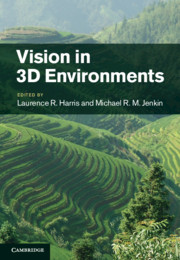Book contents
- Frontmatter
- Contents
- List of contributors
- 1 Seeing in three dimensions
- Part I Depth processing and stereopsis
- 2 Physiologically based models of binocular depth perception
- 3 The Influence of monocular regions on the binocular perception of spatial layout
- 4 Information, illusion, and constancy in telestereoscopic viewing
- 5 The role of disparity interactions in perception of the 3D environment
- 6 Blur and perceived depth
- 7 Neuronal interactions and their role in solving the stereo correspondence problem
- Part II Motion and navigation in 3D
- Part III Natural-scene perception
- Author Index
- Subject Index
2 - Physiologically based models of binocular depth perception
from Part I - Depth processing and stereopsis
Published online by Cambridge University Press: 05 August 2011
- Frontmatter
- Contents
- List of contributors
- 1 Seeing in three dimensions
- Part I Depth processing and stereopsis
- 2 Physiologically based models of binocular depth perception
- 3 The Influence of monocular regions on the binocular perception of spatial layout
- 4 Information, illusion, and constancy in telestereoscopic viewing
- 5 The role of disparity interactions in perception of the 3D environment
- 6 Blur and perceived depth
- 7 Neuronal interactions and their role in solving the stereo correspondence problem
- Part II Motion and navigation in 3D
- Part III Natural-scene perception
- Author Index
- Subject Index
Summary
Introduction
We perceive the world as three-dimensional. The inputs to our visual system, however, are only a pair of two-dimensional projections on the two retinal surfaces. As emphasized by Marr and Poggio (1976), it is generally impossible to uniquely determine the three-dimensional world from its two-dimensional retinal projections. How, then, do we usually perceive a well-defined three-dimensional environment? It has long been recognized that, since the world we live in is not random, the visual system has evolved and developed to take advantage of the world's statistical regularities, which are reflected in the retinal images. Some of these image regularities, termed depth cues, are interpreted by the visual system as depth. Numerous depth cues have been discovered. Many of them, such as perspective, shading, texture, motion, and occlusion, are present in the retina of a single eye, and are thus called monocular depth cues. Other cues are called binocular, as they result from comparing the two retinal projections. In the following, we will review our physiologically based models for three binocular depth cues: horizontal disparity (Qian, 1994; Chen and Qian, 2004), vertical disparity (Matthews et al., 2003), and interocular time delay (Qian and Andersen, 1994; Qian and Freeman, 2009). We have also constructed a model for depth perception from monocularly occluded regions (Assee and Qian, 2007), another binocular depth cue, but have omitted it here owing to space limitations.
Information
- Type
- Chapter
- Information
- Vision in 3D Environments , pp. 11 - 45Publisher: Cambridge University PressPrint publication year: 2011
Accessibility standard: Unknown
Why this information is here
This section outlines the accessibility features of this content - including support for screen readers, full keyboard navigation and high-contrast display options. This may not be relevant for you.Accessibility Information
- 1
- Cited by
